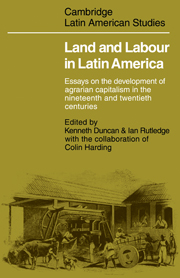 Land and Labourin Latin America
Land and Labourin Latin America Book contents
- Frontmatter
- Contents
- List of tables
- List of figures
- List of maps
- Acknowledgements
- 1 Introduction: patterns of agrarian capitalism in Latin America
- PART I THE TRANSITION FROM TRADITIONAL HACIENDA TO CAPITALIST ESTATE
- PART II THE DEVELOPMENT OF A PLANTATION ECONOMY WITH LABOUR RECRUITMENT FROM HIGHLAND PEASANT COMMUNITIES
- PART III THE DEVELOPMENT OF COMMERCIAL AGRICULTURE USING EUROPEAN IMMIGRANT LABOUR
- PART IV THE TRANSITION FROM SLAVE PLANTATION TO CAPITALIST PLANTATION
- PART V POSTSCRIPT
- Glossary of Spanish and Portuguese terms used in the text
- Weights and measures
- Notes on contributors
- Indexes Subjects
- Authors
PART III - THE DEVELOPMENT OF COMMERCIAL AGRICULTURE USING EUROPEAN IMMIGRANT LABOUR
Published online by Cambridge University Press: 07 May 2010
- Frontmatter
- Contents
- List of tables
- List of figures
- List of maps
- Acknowledgements
- 1 Introduction: patterns of agrarian capitalism in Latin America
- PART I THE TRANSITION FROM TRADITIONAL HACIENDA TO CAPITALIST ESTATE
- PART II THE DEVELOPMENT OF A PLANTATION ECONOMY WITH LABOUR RECRUITMENT FROM HIGHLAND PEASANT COMMUNITIES
- PART III THE DEVELOPMENT OF COMMERCIAL AGRICULTURE USING EUROPEAN IMMIGRANT LABOUR
- PART IV THE TRANSITION FROM SLAVE PLANTATION TO CAPITALIST PLANTATION
- PART V POSTSCRIPT
- Glossary of Spanish and Portuguese terms used in the text
- Weights and measures
- Notes on contributors
- Indexes Subjects
- Authors
Summary
In so far as its starting point for the analysis of the process of agrarian change is the demise of the slave plantation system, Thomas H. Holloway's essay on labour organization in the Brazilian coffee industry provides certain points of contact with the papers included in Part IV. However, in this particular case the social and economic changes resulting from the large-scale immigration of European labour were so massive and far-reaching that they render any discussion of the changing status of the slaves themselves of minimal interest compared with the examples studied in the final section. Whereas-in the case of northeast Brazil's sugar cane industry an uncertain future for the commodity's markets meant that the decline and abolition of slavery was not accompanied by a relative shortage of labour (see the papers by Peter L. Eisenberg and Jaime Reis in Part IV), in the Sao Paulo region the decline of slavery occurred precisely at the time when great new opportunities were opening up for the cultivation and export of coffee. The coffee planters could never have taken full advantage of these new possibilities if they had tried to rely on local Negro labour; it is doubtful if even inter-regional transfers of ex-slaves would have supplied the quantity of manpower required. Instead, by encouraging the immigration of vast numbers of European labourers (mainly Italians) they totally transformed the social structure of the state of Sao Paulo.
- Type
- Chapter
- Information
- Land and Labourin Latin AmericaEssays on the Development of Agrarian Capitalism in the nineteenth and twentieth centuries, pp. 299 - 300Publisher: Cambridge University PressPrint publication year: 1978


